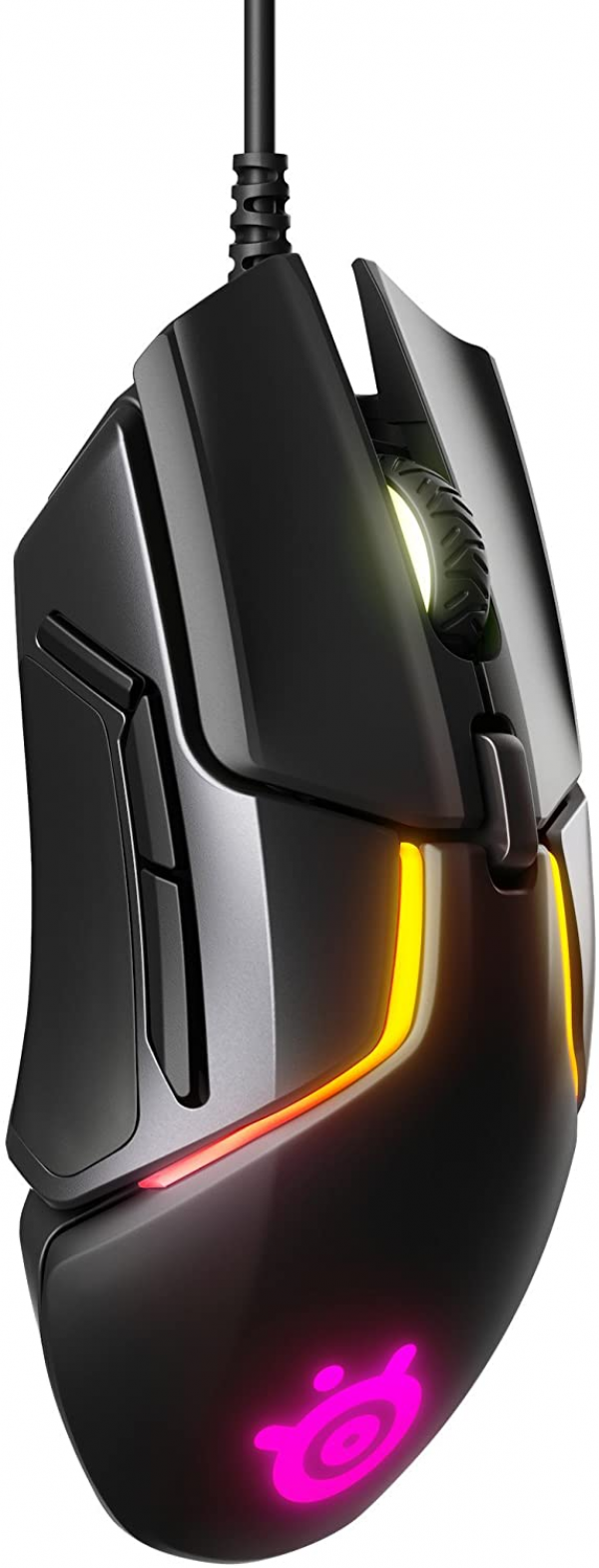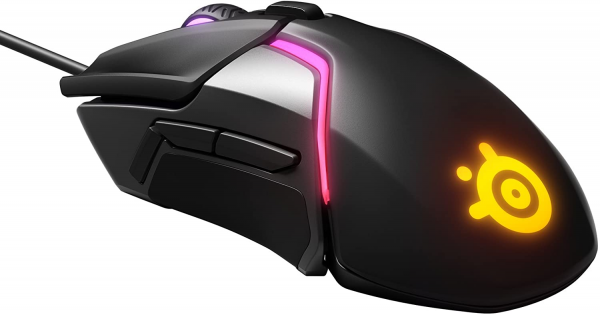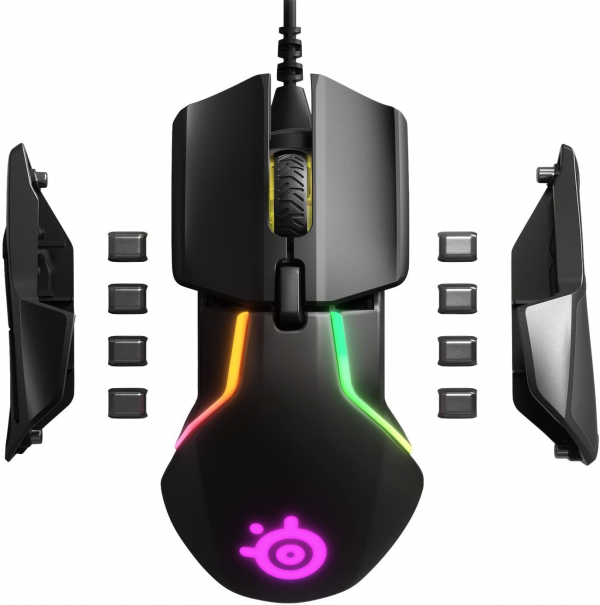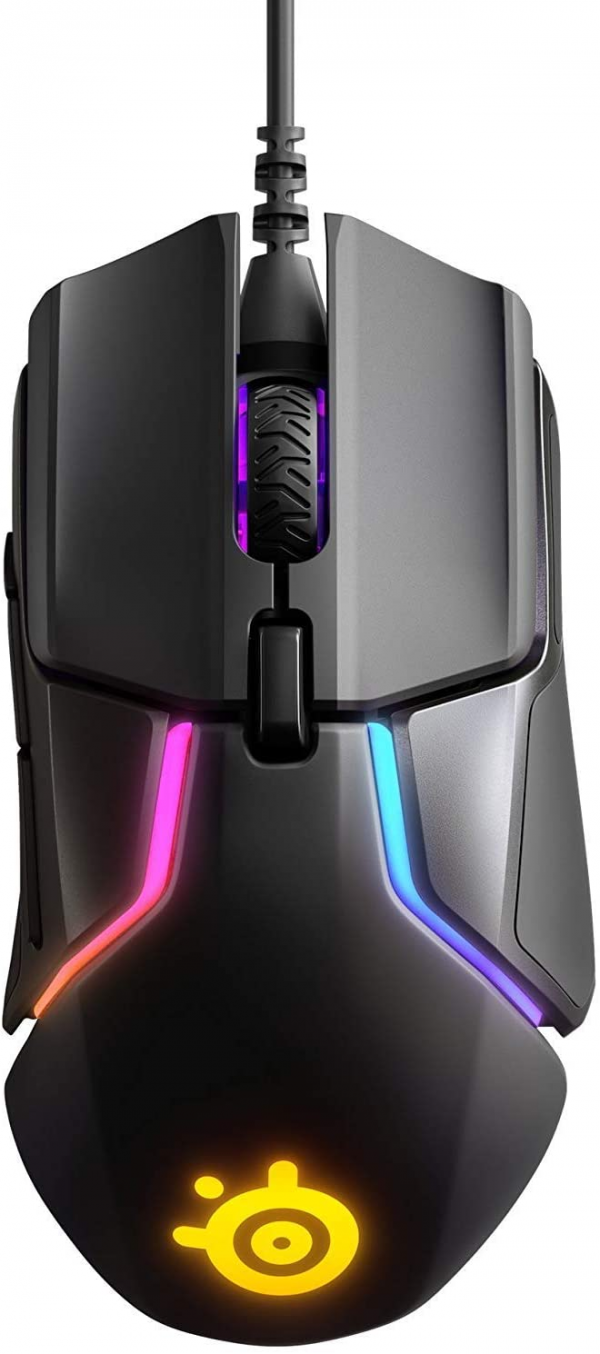SteelSeries
SteelSeries Rival 600 mouse: double optical sensor for increased stability
Aprox. 75€ - see price -
See specificationsA good optical sensor is good. But is two sensors even better? This is the question that can be asked when discovering the Rival 600 from SteelSeries. This gaming mouse therefore uses a second sensor dedicated exclusively to depth measurement, for an even more precise detection of the lifting distance. What outperform the competition?
Positive points
Comfort of handling.
Good build quality.
Adjustable mass and balance.
Excellent optical sensor.
The second sensor is not a gadget, although it will not be useful to everyone.
Bad points
Only 2 configurable sensitivity levels.
Third slice button not very accessible (except for very large hands).
Slightly slippery straight edge.
Our review
Ergonomics
Like the Rival 310, the Rival 600 is intended only for right-handers because of its asymmetrical shape, tilted to the right to better match the curves of the hand. This results in a very comfortable grip for right-handers, provided that one does not have a hand that is too short, because the mouse is quite long (131 x 69 x 43 mm). However, it remains quite fine. Its proportions are finally halfway between those of the Logitech G502 (132 x 75 x 40 mm) and the Logitech G403 (124 x 68 x 43 mm).
The grip is improved by silicone inserts on the edges, soft to the touch but also completely smooth, therefore less non-slip than those used on the Rival 310 and Sensei 310. If this is not a problem on the left edge, because it is slightly concave, it is more annoying on the right is conversely slightly convex. Immediate consequence: the fingers slide a little if the pressure is released too much. It is not necessarily very annoying in a nervous game where the intensity of the action naturally makes the mouse shake fairly firmly, but it is more annoying for quieter uses, if one needs to frequently lift his mouse to center it on the mat (multi- screen configuration, use in low sensitivity ...).
Fortunately, the fluidity of movement of the Rival 600 is very good thanks to its lightness. With only 97 g on our scale (96 g advertised and 103 g if you measure with the cable connected - it is removable - and placed next to it), the mouse slides with agility on the mat, helped by its 3 PTFE pads. SteelSeries has nevertheless thought of players who prefer heavier mice and offers an adjustment system based on 8 small masses of 4 g each, to be inserted under the slices of the mouse. Rather well thought out, it also allows you to change the balance of the Rival 600. The installation of small masses could have been easier, but once your preferences found, we should not in principle do not touch it.
Regarding the buttons, we appreciate the concave shape of the two main ones which improves the retention of the fingers in a good position by preventing them in particular from sliding outwards. Without achieving the excellence of the latest Logitech mice in this area, the clicks are fairly responsive and offer a satisfactory consistency. There is, however, a click quality of the right button very slightly lower than that of the left, giving an impression of slightly lower reactivity. The click noise is quite discreet.
On the side of the slice buttons, we appreciate their good positioning: they are close to the thumb without being too prominent not to incur unwanted activations. Their trigger is quite frank. In addition to the two buttons now usual, there is a third positioned in front of the thumb. It is unfortunately not easy to reach, unless you have a very long thumb, making it difficult to use in the heat of the moment. It will therefore be assigned rather a function of less importance, which is unfortunate insofar as such a button can, on certain mice, be used to lower the sensitivity of the sensor on the fly when it is held down in order to increase accuracy (hence its button name "sniper"). This role can nevertheless be played by the last button finding its place above the wheel, which allows you to switch from one level of sensitivity of the sensor to another (default function). Since the mouse only manages 2 sensitivity settings at a time, we can easily press this button for such a function, especially since it is possible to operate it with the middle of the finger without too much difficulty.
The wheel, for its part, turns out to be quite well notched while remaining fairly soft. It cannot be tilted laterally (for horizontal scrolling or to add two other functions, for example).
A few words finally on the backlight. Very neat, it can vary with great fluidity according to several configurable effects in the mouse software. 8 zones are illuminated: wheel, logo, as well as 2 bands on the top of the mouse, each subdivided into 3 zones (one LED per zone). Synchronization is possible with other brand devices and some games and applications (including Discord) support the backlight directly.

Precision
The Rival 600 uses the TrueMove3 sensor, manufactured by PixArt and already used in the Rival 310 and Sensei 310. An excellent optical sensor, capable of supporting accelerations up to 50 g and operating at speeds of up to 8.9 m / s. Impossible to get it off the hook: the most abrupt movements are perfectly managed, and always with excellent precision. This sensor also allows 1: 1 optical tracking (tracking) over a range of 100 to 3500 dpi, for faithful capture and without acceleration. SteelSeries also recommends choosing sensitivities in this slightly narrower range to maximize accuracy.
If 3500 dpi will already be enough for most players, including those who enjoy playing at high sensitivity, the TrueMove3 can still climb up to 12,000 dpi, much more than it takes, even to exploit multi-monitor configurations in Ultra HD. Remember that at 12,000 dpi, a movement of less than a centimeter is enough to cover the entire width of an Ultra HD screen: goodbye precision under these conditions - we also appreciate that SteelSeries itself explains that sensitivity has nothing to do with precision.
Although we are actually in the presence of a TrueMove3 sensor, SteelSeries adds here however the suffix "+" to its name to mark the presence of a second optical sensor. The latter is only used to measure the lifting height of the mouse, for greater measurement accuracy. Thanks to this second sensor, there is no need to lift your mouse very high, since the lift-off height is extremely low here: it can be adjusted up to 0.5 mm. So just a tiny lift to stop the movement of the mouse pointer. You gain speed of execution and comfort if you have the habit of frequently refocusing your mouse on the carpet (game in low sensitivity, especially). However, it should be noted that such a capacity will not be useful to everyone, because many players can accommodate a higher cutting height (between 1.5 and 2 mm, for example).
Take care when adjusting this detection height as well, since a too low level prevents the mouse from working on certain surfaces. As a precaution, it would be better to increase the cutting height before using your mouse on another covering, or else have a second mouse on hand. The height can then be reduced again without problem, the sensor automatically adapting to the surface - it is simply the passage from one surface to another which can cause it problems when the lift-off setting is low.

Conclusion
Pleasant to handle, very precise and fast, well constructed, the SteelSeries Rival 600 has few faults. Without being essential to all players, its second sensor does not lack interest, increasing the stability during lifting of the mouse. Those who have nothing to do with an ultra-reduced cutting height and the adjustment of the mass of this mouse will however turn more easily to a less expensive Rival 310, already very satisfactory, although a little less comfortable under the hand.

Specifications

